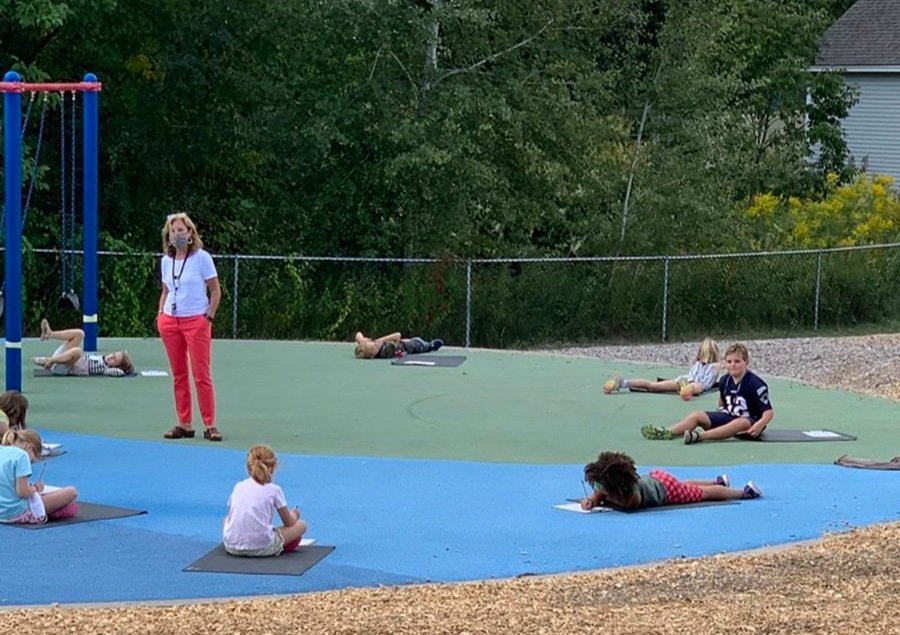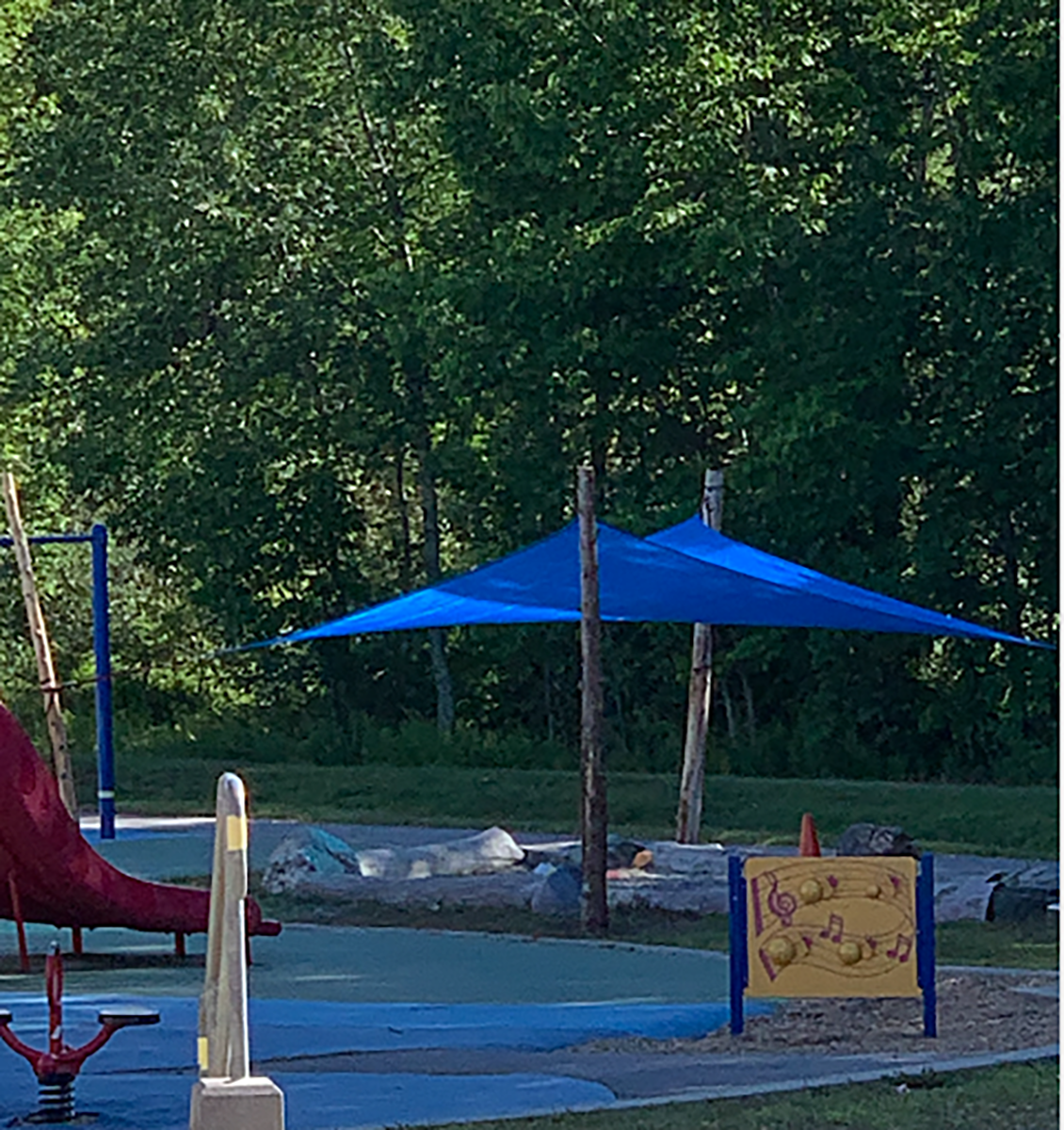Falmouth Public Schools
Falmouth, Maine
Falmouth School District serves the Portland, Maine, suburb of Falmouth, a city of about 11,000 residents. The district's three K–12 schools serve about 2,200 students and employs 250 staff members. The district combined all three schools onto one campus, which enables district programming to be implemented easily. At the start of the 2020–2021 school year, with the help of about $100,000 of its CARES Federal Relief funding, about a dozen staff members worked to create 30 outdoor learning spaces. They identified 80 more sites for outdoor learning during the year.
Hallmarks of Falmouth School District’s outdoor learning strategy is utilizing their existing resources and programs—such as their farm-to-school program, looking for new opportunities, and involving the whole school district community. The ECO (Educating Children Outdoors!) Team played a pivotal role in helping the whole community feel prepared and supported as they jumped into outdoor learning in the fall of 2020. Staff actively participated in the construction, maintenance, and coordination of these outdoor spaces, as did student volunteers. For the 2021–2022 school year, they are continuing to utilize and expand their outdoor learning programming, for during the pandemic and beyond.
Previous Programming and Pandemic Response
INTERVIEW WITH SCHOOL DISTRICT Staff
In October 2020, Falmouth School District staff members, Justin Deri, FPS Garden and Greenhouse Coordinator, and colleague Cathlyn Langston met with Andra Yeghoian and Naomi Stern of the San Mateo County Office of Education to discuss the district’s current outdoor learning programming and COVID-19 response.
Q: What existing outdoor learning programs do Falmouth Public Schools operate?
Falmouth Public Schools has an established Falmouth Farm-to-School program that was founded to promote sustainability, food justice, and health education. The farm-to-school program has a multi-pronged approach towards their mission: procurement of local food, onsite outdoor garden spaces, and agriculture education that is integrated into each school's curriculum. In 2016, the school hired a full-time garden manager who assists teachers in leading project-based activities across all subjects and grade levels. Annually, the garden manager hosts close to 100 classroom visits.
In addition to the farm-to-school program, Falmouth Public Schools has established wellness and nature goals for their campus grounds. In 2010, all three schools in the district were moved onto one campus, making it easier to integrate this programming across all grade levels. Through grassroots support and fundraising, the district has enhanced their outdoor spaces to include the learning garden, a system of nature trails, a wetland pond, and natural play structures.
Above: Parent volunteers.
At the November 5, 2020 Community of Practice meeting, Justin Deri, Garden Coordinator at FPS, discussed the planning and implementation processes FPS used to bring learning outside this year. Click on the video above to watch or skip to 28:00 for FPS’s presentation.
District Education Data
3 public schools
2,200 K–12 students
250 district staff, including teachers
Location
Southern Maine, along the Atlantic Ocean coast
Falmouth, Maine, a small suburb of Portland, Maine, with about 11,000 residents
Climate
Warm, humid spring and fall weather: 45°F–60°F
Cold, snowy winters: Average daytime temperatures 15°F–40°F for 3+ months
Mild summers: 55°F–75°F
Precipitation: 131 days per year
Rainfall: 47” per year
Snowfall: 69” per year
Q: How did your school district decide to bring education outside this year?
Teachers, with the support of district administrators, have been the main drivers for outdoor learning in relation to COVID-19 recovery at Falmouth Public Schools. Justin Deri, the farm manager, inspired faculty to research this concept, and they had initial inspiration and support from the Maine Outdoor Education Program. The Falmouth Public Schools Superintendent Geoff Bruno was supportive of this planning process from the beginning and encouraged faculty to work together to create a plan for outdoor learning.
Ten-to-twelve staff members, led by Justin and colleague Cathlyn Langston, met frequently and formed an ECO (Educating Children Outdoors!) Team dedicated to researching outdoor learning infrastructure, assessing potential sites on their campus, and developing scheduling procedures for outdoor classroom use. The ECO Team developed an outdoor learning goal focused on giving all classes the resources and materials they would need to easily move their classes outdoors with flexibility and ease.
Falmouth Public Schools allocated $100,000 from CARES Federal Relief funds to prepare outdoor classroom spaces. The Falmouth School District was able to dedicate these funds in part because their buildings are fairly new and already equipped with HVAC and heating systems. In addition, with all three of their schools on one campus, some parts of facilities management and operations are more streamlined.
Top: Shade canopy in forested area.
Bottom: Shade canopy.
Above: Falmouth “Jump Outdoors Bag.”
Q: How did you prepare staff to take classes outdoors?
By the start of the 2020–2021 school year, Falmouth will have 30 different outdoor learning sites prepared on their campus. Each site has been assigned a number and description and placed into a shared spreadsheet. Faculty will use the Google Calendar app, a tool the district has used previously, to reserve an outdoor classroom site. This method will reduce the potential for overlap of teachers using outdoor space and allow administration to track where classes are at what time of the school day. Members of the ECO Team trained all staff members on outdoor classroom safety policies, including cell-phone use for emergencies and communication with the nursing staff.
The ECO Team has prepared “Jump Outdoors Bags” for each teacher, including all of the needed materials so teachers can easily get outside and go to any available location on campus. Each bag includes supplies for both teachers and students. For teachers, the bags have prepared medical supplies, teaching equipment, and an ALPS three-legged stool. Students have a clipboard, dry erase markers, art supplies, and more.
Q: What was involved in the infrastructure implementation process?
Many different approaches to infrastructure are being used depending on each site's unique factors. The staff's biggest hurdle was finding and placing tents that meet local fire department safety regulations. In some locations, they are using repurposed sails as shade canopies. In other places, they have been able to install shade fabric to cedar posts. For seating they have used existing tables, logs, and straw bales. Straw bales are a huge hit with students and teachers and are across the campus in pods of 10 to 12, ready for cohorts to use.
The ECO Team organized community volunteers to help with distributing materials and setting up infrastructure. These workdays were a big part of the success of this program so far.
Above: Delivery of straw bales.
Q: What is next for Falmouth in the outdoor learning process?
After school starts, construction and planning will continue to add to the existing outdoor classroom sites. Staff will continue to rally community support for construction and fundraising. Over 80 sites have been identified for outdoor classroom use (not including sports facilities), and staff will continue to invest in the infrastructure needed to turn these into learning environments. Additionally, the school is planning to extend into the colder months by investing in additional greenhouse space and appropriate clothing so all students can be comfortable outdoors. They are planning to expand their greenhouses as part of the long-term farm-to-school programming.
Above: Student volunteer.
COVID-Related Planning Resources from FPS
Falmouth Public Schools Reopening Plan (Fall 2020)
Falmouth Public Schools—Outdoor Learning Case Study
— Naomi Stern and Andra Yeghoian, San Mateo County Office of Education, October 2020
Outdoor Classroom Site Planning:
ECO (Education Children Outdoors!) Team:
Outdoor Teaching and Learning Supplies Lists 2020–2021:
Site Maps of Outdoor Classroom Possibilities:
Slide Decks with Outdoor Classroom Design Considerations:
Falmouth Elementary School—Outdoor Classroom Design Considerations (Google Slides)
Falmouth Middle School—Outdoor Classroom Design Considerations (Google Slides)
Falmouth High School—Outdoor Classroom Design Considerations (Google Slides)
Outdoor Classroom Use, Curriculum, and Instruction:
Helpful Tips for Using Learning Spaces—Elementary Grade Levels (FPS)
Teacher Tips for Outdoor Classroom Behavior Management (FPS)
Introduction to Outdoor Learning—Training Slide Decks for FPS Teachers: FES, FMS, FHS
ECO (Educating Children Outdoors!) Permission Form for Parents/Guardians (FPS)
Supplies and Materials:
“Jump Outdoors Bags” Materials and Pricing and Budget
Falmouth Public Schools District Website, Facebook, and Twitter
Pre-COVID Programming
Media Coverage
“Falmouth students build 'greenhouse classrooms'”
— News Center Maine, April 15, 2021
“Maine schools create outdoor classrooms”
—News Center Maine, August 28, 2020
“Will the Outdoors Become the New Classroom of the COVID Era?” (See section: The Experience in Maine)
—Governing, August 25, 2020
CREDITS
This page features an October 2020 case study produced by Naomi Stern, Green Facilities and Operations Analyst, San Mateo County Office of Education, and Andra Yeghoian, Environmental Literacy and Sustainability Coordinator, San Mateo County Office of Education, with support from Falmouth Public Schools staff, Justin Deri, Garden and Greenhouse Coordinator, and Cathlyn Langston.
This page was updated and edited in September 2021 by Lauren McKenna, Program Manager, Green Schoolyards America.
National COVID-19 Outdoor Learning Initiative
The National COVID-19 Outdoor Learning Initiative supports schools and districts around the country in their efforts to reopen safely and equitably using outdoor spaces as strategic, cost-effective solutions to increase capacity onsite and provide access to abundant fresh air. The Initiative seeks to equitably improve learning, mental and physical health, and happiness for children and adults using an affordable, time-tested outdoor approach to keeping schools open during a pandemic.













